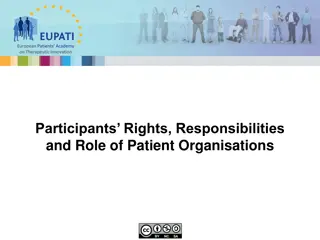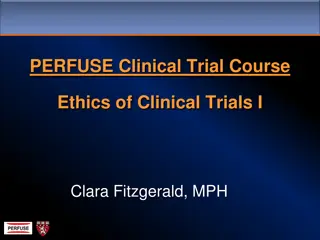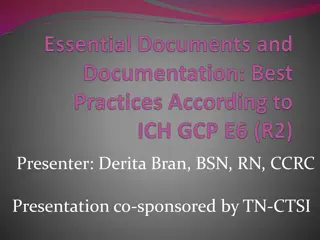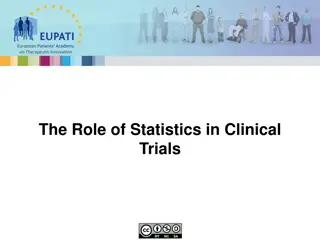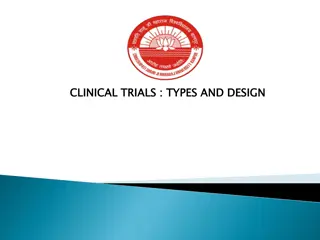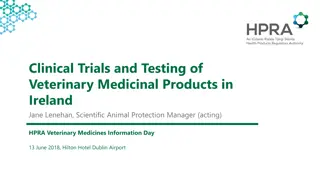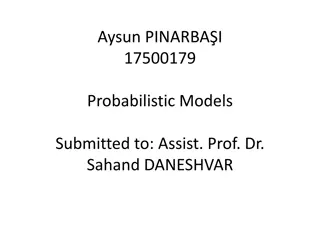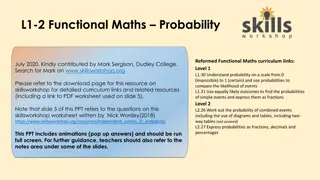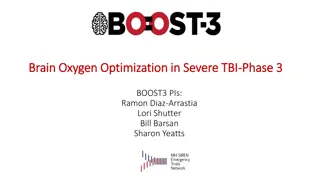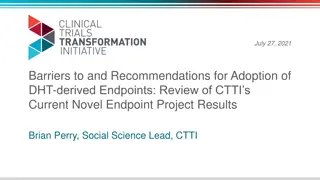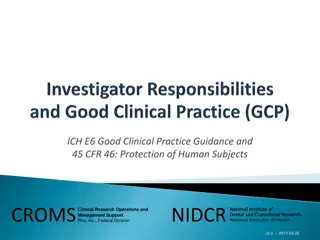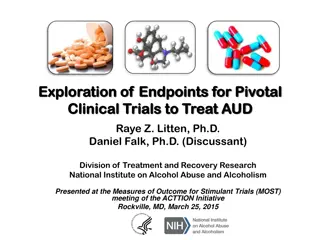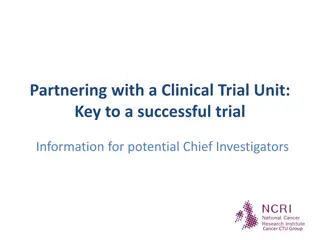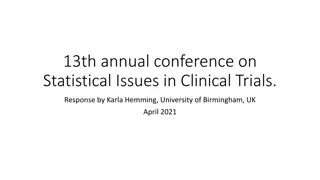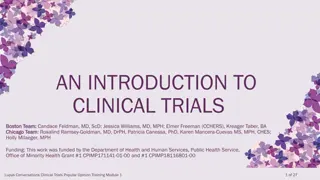Understanding Probabilities of Success in Clinical Trials
Exploring the concept of probabilities of success in clinical trials, this webinar discusses the assessment of new treatments, development plans, and success criteria. It covers factors like power, probability of success, and assurance in decision-making processes, emphasizing the consideration of available and future evidence and uncertainties. The session also delves into confidence levels regarding treatment effects and the definition of success criteria based on statistical significance and treatment effect magnitude.
Download Presentation

Please find below an Image/Link to download the presentation.
The content on the website is provided AS IS for your information and personal use only. It may not be sold, licensed, or shared on other websites without obtaining consent from the author. Download presentation by click this link. If you encounter any issues during the download, it is possible that the publisher has removed the file from their server.
E N D
Presentation Transcript
Probabilities of success GAELLE SAINT-HILARY (SERVIER) PSI/EFSPI SIG QDM WEBINAR 2, 10 DECEMBER 2019
2 Introduction Past Future Present Contextual evidence Observed data Updated evidence Future evidence Predictions Clinical trials in the same context Expert opinion, historical and co-data, literature Clinical trials Decision- making, Go/No-Go decision Extrapolations Clinical trials in a different context Prior Likelihood Posterior distribution Predictive distribution distribution PSI Webinar - Quantitative Decision-Making PSI/EFSPI SIG QDM, 10 DECEMBER 2019 Inspired from Wandel and Neuenschwander, 2017
3 Power, Probability of Success, Assurance They are all means to quantify how confident we are to meet the success criteria But what do we mean by success? Do we want to assess: How confident we are that the new treatment adds value for patients? Takes into account available evidence and uncertainties How confident we are that our development plan permits to show it? Takes into account available and future evidence and uncertainties PSI Webinar - Quantitative Decision-Making PSI/EFSPI SIG QDM, 10 DECEMBER 2019
4 Power, Probability of Success, Assurance Considering available and/or future evidence and uncertainties Definition of the success criteria PSI Webinar - Quantitative Decision-Making PSI/EFSPI SIG QDM, 10 DECEMBER 2019
5 Power, Probability of Success, Assurance Cf. previous presentation on QDM frameworks Considering present and/or future evidence and uncertainties Good confidence that treatment effect is larger than target value (? > ??) Definition of the success criteria Often based on one or several of the following conditions: Statistical significance Good confidence that treatment effect is larger than minimal value (? > ??) PSI Webinar - Quantitative Decision-Making PSI/EFSPI SIG QDM, 10 DECEMBER 2019
6 Power, Probability of Success, Assurance For example: Today, what is our confidence level that the treatment effect is large enough? We consider the posterior distribution of the treatment effect Considering available and/or future evidence and uncertainties Definition of the success criteria What is our confidence level that the treatment effect is large enough and that the future studies in the development plan permit to show it? We consider the predictive distribution of the future results in the next study PSI Webinar - Quantitative Decision-Making PSI/EFSPI SIG QDM, 10 DECEMBER 2019
7 Power, Probability of Success, Assurance Posterior Probability ( Post Prob ) quantifies the level of confidence in the targeted result (e.g. that the treatment effect is large enough) considering the available evidence (posterior distribution) Power is the PPoS when success criterion in the future trial = statistical significance, conditional on a hypothesis on the treatment effect (fixed value) Predictive Power is the unconditional PPoS when success criterion in the future trial = statistical significance Predictive Probability of Success ( PPoS ) is the probability of meeting success criteria in the future trial(s)(predictive distribution) Assurance is an other name for the PPoS Spiegelhalter et al. 2004. O Hagan et al. 2005. Gasparini et al. 2013. Walley et al. 2015 PSI Webinar - Quantitative Decision-Making PSI/EFSPI SIG QDM, 10 DECEMBER 2019
8 Motivating example: Alzheimer's disease Indication: Alzheimer's disease Primary endpoint: 11-item ADAS-Cog total score change from baseline at W24 Phase II (completed): 125 patients/arm (3 doses vs control, Bonferroni adjustment) Treatment effect estimate for the selected dose (Mean (SE)): 2.7 (0.76) Phase III (planned): We are here 1 dose vs control, 100 patients/arm (84% power if ? = 2.5, with ? = 6) Phase II (completed) Phase III (planned) In most cases, in clinical trials, there exists an estimate of the treatment difference reasonably assumed to be normally distributed We will focus on Normal distributions in this presentation PSI Webinar - Quantitative Decision-Making PSI/EFSPI SIG QDM, 10 DECEMBER 2019
9 Prior, posterior, predictive distributions Notations Prior and likelihood Before development: prior distribution ? ~ ? ?0,?0 Past study: Estimate (var) ?1 ?1 We denote ? = 2 2, Likelihood (sampling distribution) ?1 | ? ~ ?(?,?1 ?1 ?0 2) 2 2 2?1 2+?1 2 ?0 2+?1 ?0 ?0 2?0 and ?2= 2?1+ 2+?1 2 ?0 Simplified case-study using normally distributed data, assuming trial exchangeability, common known variance for the two groups and no between- study heterogeneity Today Posterior distribution ? | ???? ~ ? ?,?2 Future study Estimate (var) Likelihood (sampling distribution) Predictive distribution ? ? 2 ? | ? ~ ?(?,? 2) ? ~ ? ?,?2+ ? 2 PSI Webinar - Quantitative Decision-Making PSI/EFSPI SIG QDM, 10 DECEMBER 2019
10 Prior, posterior, predictive distributions Example: Alzheimer's disease Posterior ?|?~? ?,?? Prior ? ~ ? ?,??? Vague prior Likelihood next study ? |? = ?.?~?(?.?,? ?) Predictive ? ~?(?,??+ ? ?) PSI Webinar - Quantitative Decision-Making PSI/EFSPI SIG QDM, 10 DECEMBER 2019
11 Prior, posterior, predictive distributions Example: Alzheimer's disease Posterior ?|?~? ?,?? Prior ? ~ ? ?,??? Vague prior Likelihood next study ? |? = ?.?~?(?.?,? ?) Predictive ? ~?(?,??+ ? ?) 2.5 2.7 PSI Webinar - Quantitative Decision-Making PSI/EFSPI SIG QDM, 10 DECEMBER 2019
12 Prior, posterior, predictive distributions Example: Alzheimer's disease Posterior ?|?~? ?,?? Prior ? ~ ? ?,??? Vague prior Likelihood next study ? |? = ?.?~?(?.?,? ?) Predictive ? ~?(?,??+ ? ?) Var (predictive) = Var (posterior) + Var (likelihood) PSI Webinar - Quantitative Decision-Making PSI/EFSPI SIG QDM, 10 DECEMBER 2019
13 Posterior Probability to support today s decision from available evidence and uncertainties ? = treatment difference Posterior distribution: ? | ????~ ? ?,?2 MV = 2, minimum value of treatment effect for the new medicine to add value for patients Example of decision criterion: GO if we are confident enough that the treatment effect is clinically meaningful E.g. GO if Post Prob = P ? > ?? ???? > 0.8 Otherwise STOP ?? ? ? ???? ???? = ? ? > ?? | ???? = ? ? PSI Webinar - Quantitative Decision-Making PSI/EFSPI SIG QDM, 10 DECEMBER 2019
14 Predictive Probability of Success (PPoS) to support today s decision from available and future evidence and uncertainties ? = treatment difference, ? = estimate of ? in the next trial, which is planned and designed Predictive distribution: ? ~ ? ?,?2+ ? 2 MV = 2, minimum value of treatment effect for the new medicine to add value for patients Example of decision criterion: GO if we are confident enough that the null hypothesis H0 : ? 0 will be rejected at level ?and that the estimated treatment effect will be clinically meaningful in the next study E.g. GO if PPoS = P (? > ??? ) (? > ??) > 0.6 Otherwise STOP ???(??? ,??) ? ??+ ? ? ???? = ? ? > ???(??? ,??) = ? ? ??= 1 ? 100? percentile of the standard normal distribution PSI Webinar - Quantitative Decision-Making PSI/EFSPI SIG QDM, 10 DECEMBER 2019
15 Power, Posterior Prob, PPoS Example: Alzheimer's disease Posterior ?|?~? ?,?? Prior ? ~ ? ?,??? Post Prob= 82% Vague prior Likelihood next study ? |? = ?.?~?(?.?,? ?) Predictive ? ~?(?,??+ ? ?) Power next study = 84% PPoS= 73% Probability of statistical significance in next study, conditional on a hypothesis on the treatment effect (fixed value, 2.5 here) Critical value 1.66 MV=2 PSI Webinar - Quantitative Decision-Making PSI/EFSPI SIG QDM, 10 DECEMBER 2019
16 Operating characteristics, sample size planning Example: Alzheimer's disease Operating characteristics based on Posterior Probability and PPoS are useful to design studies Conditional operating characteristics before Phase II Prob( Post Prob > 0.8 | true mean) PPoS Phase III versus observed treatment difference in Phase II N=60 /arm N=125 /arm N=150 /arm N/arm in Phase II False GO, if true mean = 0 0.4% 0% 0% False STOP, if true mean = 3 47.2% 31.7% 27.4% Correct STOP, if true mean = 0 99.6% 100% 100% Correct GO, if true mean = 3 52.8% 68.3% 72.6% PPoS could be used for sample size planning at the development level E.g. sample size planning for phase II based on PPoS for Phase III G tte et al. 2015 PSI Webinar - Quantitative Decision-Making PSI/EFSPI SIG QDM, 10 DECEMBER 2019
17 What level of Posterior Probability/PPoS is needed to support a Go decision? The Post Prob and PPoS depend on the success criteria, the design of the studies (in particular, the sample size) and the amount of uncertainty about the treatment effect The target level for a Go decision should be chosen based on What is achievable (assessed using operating characteristics, conditional on fixed values or using informative priors) What is desirable in the context: what level of risk is acceptable to make a decision? E.g. Well understood disease, highly competitive environment Low level of acceptable risk High unmet need, high risk of development failure Higher level of acceptable risk Note on classical Power vs Predictive Power Predictive Power takes into account uncertainties about the treatment effect There is a limit of how high it can be, which depends on the amount of available uncertainty Power in confirmatory trials is usually 80% or 90% Based on an assumption about the treatment effect Could always be increased by increasing the sample size Crisp et al. 2018 PSI Webinar - Quantitative Decision-Making PSI/EFSPI SIG QDM, 10 DECEMBER 2019
18 Extensions, other settings Several prior studies: estimate based on (network-) meta-analysis Several future studies: probability to reach the criteria in each study Interim analysis: probability to reach the criteria at the end of the study given the results at the interim (independent increments) Multiple endpoints / Multiple doses Type 1 error adjustment for multiple comparisons if needed Joint distributions Bias: selection of doses or populations overestimation of treatment effect overestimation of probabilities of success bias correction needed Decision-making based on surrogate endpoints Patient-level or trial-level surrogacy (Saint-Hilary et al. 2019) PSI Webinar - Quantitative Decision-Making PSI/EFSPI SIG QDM, 10 DECEMBER 2019
19 Discussion Posterior Probability and PPoS help decision-making At the study level (planning, interim analyses, ) At the development level when assessing Development strategies Strategic milestones Due-diligences Global project value assessment Choosing between Posterior Probability or PPoS to define the Go/No-Go criteria depends on the question of interest (related to the treatment effect only, or also to the success of future trials) and the context (future studies already planned and designed?) PSI Webinar - Quantitative Decision-Making PSI/EFSPI SIG QDM, 10 DECEMBER 2019
20 Lessons learned from the webinars Quantitative Decision-Making in Drug Development QDM provides value to trial level, program level and portfolio level decision-making There is an awareness of QDM methods among statisticians and, to a lesser extent, also among non-statisticians and decision-makers However, statisticians are not seen as leaders in decision-making processes Many quantitative methods exist but some of them still remain unknown or unused QDM is currently used mainly in clinical development Pre-specification of QDM frameworks with quantitative criteria is a driver for better decision-making Statistical methods e.g. probabilities of success permit to quantify uncertainty QDM facilitates better cross-functional communication and planning PSI/EFSPI SIG QDM, 3 & 10 DECEMBER 2019 PSI Webinar - Quantitative Decision-Making
21 References Wandel, S, and Neuenschwander, B (2017). Bayesian Clinical Trials Workshop, Ulm University, Germany, October 4-5. Spiegelhalter, DJ, Abramsn, KR, and Myles, JP (2004). Bayesian approaches to clinical trials and health-care evaluation. John Wiley & Sons Ltd, Chichester, UK. O Hagan, A, Stevens, JW, and Campbell, MJ (2005). Assurance in clinical trial design. Pharmaceutical Statistics 4, 187 201. Walley RJ, Smith CL, Gale JD, Woodward P (2015). Advantages of a wholly Bayesian approach to assessing efficacy in early drug development: a case study. Pharm Stat. 14(3):205-15. doi: 10.1002/pst.1675. Gasparini, M, Di Scala, L, Bretz, F, and Racine-Poon, A (2013). Predictive probability of success in clinical drug development. Epidemiology Biostatistics and Public Health 10-1, e8760-1-14. G tte, H, Sch ler, A, Kirchner, M, and Kieser, M (2015). Sample size planning for phase II trials based on success probabilities for phase III. Pharmaceutical Statistics; 14: 515 524. doi: 10.1002/pst.1717. Crisp, A, Miller, S, Thompson, D, Best, N. (2018). Practical experiences of adopting assurance as a quantitative framework to support decision making in drug development. Pharmaceutical Statistics; 17: 317 328. doi: 10.1002/pst.1856 Saint Hilary, G, Barboux, V, Pannaux, M, Gasparini, M, Robert, V, and Mastrantonio, G (2019). Predictive probability of success using surrogate endpoints. Statistics in Medicine; 38: 1753 1774. doi: 10.1002/sim.8060 PSI Webinar - Quantitative Decision-Making PSI/EFSPI SIG QDM, 10 DECEMBER 2019




